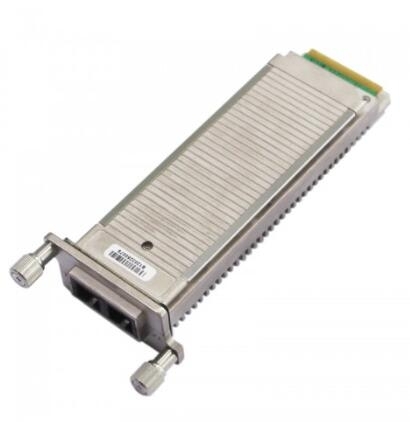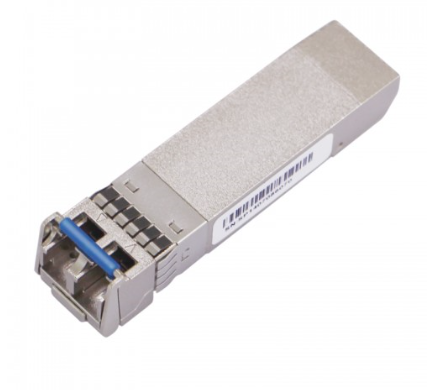- Related articles
- All Cisco GLC-BX40-DA-I's information (List price, Specs, Datasheet PDF, Compatibility mat
- All Cisco QSFP-40GE-LR4’s Information (Overview, Features, Datasheet PDF, Price, Specifica
- What is media converter in network?
- All Cisco ONS-XC-10G-L2's information (List price, Specs, Datasheet PDF, Compatibility mat
- All Cisco DWDM-XENPAK-51.72's information (List price, Specs, Datasheet PDF, Compatibility
- Optical Transceivers for Cisco WS-C4948-S Switch
- All Cisco DWDM-XFP-32.68's information (List price, Specs, Datasheet PDF, Compatibility ma
- Optical Transceivers for Cisco WS-C3560CG-8TC-S Switch
- All Cisco ONS-SE-GE-BXD's information (List price, Specs, Datasheet PDF, Compatibility mat
- Difference between XENPAK and SFP+

Definition:
XENPAK is a multisource agreement (MSA), instigated by Agilent Technologies and Agere Systems, that defines a fiber-optic or wired transceiver module which conforms to the 10 Gigabit Ethernet (10GbE) standard of the Institute of Electrical and Electronics Engineers (IEEE) 802.3 working group. The MSA group received input from both transceiver and equipment manufacturers during the definition process. XENPAK has been replaced by more compact devices providing the same functionality.
The enhanced small form-factor pluggable (SFP+) is an enhanced version of the SFP that supports data rates up to 16 Gbit/s. The SFP+ specification was first published on May 9, 2006, and version 4.1 published on July 6, 2009. SFP+ supports 8 Gbit/s Fibre Channel, 10 Gigabit Ethernet and Optical Transport Network standard OTU2. It is a popular industry format supported by many network component vendors. 10 Gbit/s SFP+ modules are exactly the same dimensions as regular SFPs, allowing the equipment manufacturer to re-use existing physical designs for 24 and 48-port switches and modular linecards.
Difference between XENPAK and SFP+:
XENPAK modules were supplied for physical layer interfaces supporting multi-mode and single mode fiber optic cables and InfiniBand copper cables with connectors known as CX4. Transmission distances vary from 100 metres (330 ft) to 80 kilometres (50 mi) for fiber and up to 15 metres (49 ft) on CX4 cable. Newer XENPAKs using the 10GBase-LX4 standard operated using multiple wavelengths on legacy multi-mode fibres at distances of up to 300 metres (980 ft), eliminating the need to reinstall cable in a building when upgrading certain 1 Gbit/s circuits to 10 Gbit/s.
Although the SFP+ standard does not include mention of 16G Fibre Channel it can be used at this speed. Besides the data rate, the big difference between 8G Fibre Channel and 16G Fibre Channel is the encoding method. 64b/66b encoding used for 16G is a more efficient encoding mechanism than 8b/10b used for 8G, and allows for the data rate to double without doubling the line rate. The result is the 14.025 Gbit/s line rate for 16G Fibre Channel. In comparison to earlier XENPAK or XFP modules, SFP+ modules leave more circuitry to be implemented on the host board instead of inside the module. Through the use of an active electronic adapter, SFP+ modules may be used in older equipment with XENPAK ports.
What are the differences between these different packages?
The 10G SFP+ optical module is an upgraded version of the SFP optical module and is based on the SFP package. The 10G XFP optical module is based on the XFP package standard.
1. The appearance of the size of the optical module
The 10G SFP+ optical module has a smaller external size than the 10G XFP optical module, so the 10G SFP+ optical module can meet the volume requirements of the high-density board for the optical module.
However, due to the large size of the 10G XFP optical module, its heat dissipation function is easier to dissipate than the 10G SFP.
2. Optical module dispersion compensation function (EDC)
The 10G SFP+ optical module has moved the signal modulation function, serializer/deserializer, MAC, clock and data recovery (CDR), and electronic dispersion compensation (EDC) functions from the module to the motherboard card. So 10G SFP+ has no EDC function.
However, the 10G XFP optical module also has this function. Therefore, when the switch router does not integrate the functions required by the 10G SFP+ optical module on the main board, it needs to be compensated by the 10G XFP optical module.。
3. The cost of the optical module
10G SFP+ optical modules are cheaper than 10G XFP, XENPAK, and X2 optical modules, and can interoperate with other types of 10G optical modules.In the 10G communication field, the SFP+ can be directly connected using a high-speed cable (DAC) with two 10G SFP+ optical module ports, eliminating the need to purchase two 10G SFP+ optical modules separately.However, 10G XFP, XENPAK, and X2 do not have this mode.
4. The port of the switch
The 10G SFP+ port on the switch can accept SFP optical modules, while the 10G XFP ports can only accept 10G XFP optical modules. The XENPAK and X2 optical modules can only accept fixed ports.
According to the above differences, the small size, low cost and multi-application characteristics of SFP+ optical modules are more suitable for high-density data centers.
These favorable factors also make SFP+ the most mainstream module at present, which is already small and hot swappable. Nowadays, 10G XFP optical modules have been replaced as the mainstream of the 10G market. All of the optical modules mentioned above, fiberland Ltd. are all on sale. Please feel free to contact us and we will provide you with a more professional answer.
RECENT BLOG POST
-
What is 100G CFP?
With the continuous development of 5G communication technology, 100G modules are gradually becoming popular. We know that there are many kinds of packages for 100G optical modules. From 2000 to now, the optical module package types have been rapidly developed. Its main package types are: GBIC, SFP, XENPAK, SNAP12, X2, XFP, SFP+, QSFP/QSFP+, CFP, CXP. In the fast-developing network era, some 100G optical modules avoid the risk of being eliminated, and upgraded and revised with the wave of the Internet, such as 100G CFP optical modules.
-
What is CWDM SFP? Which areas does it mainly apply to?
1. What is the CWDM SFP? The CWDM optical module is an optical module using CWDM technology to implement the connection between the existing network device and the CWDM multiplexer/demultiplexer. When used with a CWDM multiplexer/demultiplexer, CWDM optical modules can increase network capacity by transmitting multiple data channels with separate optical wavelengths (1270 nm to 1610 nm) on the same single fiber.
-
What is AOC and DAC?
AOC is the abbreviation of Active Optical Cables, which is called Active Optical Cables in Chinese. AOC active optical is to encapsulate two optical modules and cable together. Because the medium of transmission in the middle is optical cable, AOC optical module, which contains laser devices, has a higher price for DAC. However, its optical aperture is not exposed, it has high reliability, and its working distance can be customized for a long distance of less than 100 meters.
-
What is DWDM SFP? What areas does it mainly apply to?
Dense Wavelength Division Multiplexing (DWDM) technology is capable of transmitting data in an optical fiber using bit wavelength parallel transmission or string line transmission using the wavelength of the laser.It is widely used in different fields of communication networks, including long-distance backbone networks, metropolitan area networks (MANs), residential access networks, and local area networks (LANs).The DWDM optical module is the optical module that uses this technology, so the DWDM optical module has high bandwidth and long-distance transmission characteristics.
The advantages of SFP+ optical module:
1、SFP+ has a more compact outline size than the X2andXFP packages (same as SFP);
2、It has directly connected with the same type of XFP, X2, and XENPAK;
3、Cost is lower than XFP, X2, XENPAK.
What is SFP+ Transceiver Modules?
SFP+ is a next-generation, hot-pluggable, small-footprint, serial-to-serial, multi-rate optical transceiver that commonly used in 8.5GbE to 11GbE data communications and storage-area network (SAN). It is a variant of the conventional SFP optical transceiver with enhancement interface defined in SFF-8074i, SFP+ with a similar size of SFP and compliant to SFF-8472 (digital diagnostic interface for optical transceivers) that gives the end user the ability to monitor real-time parameters of the SFP, such as optical output power, optical input power, temperature, laser bias current, and transceiver supply voltage. The SFP+ module is a variant of the SFP optical transceiver.
The SFP+ module form factor is around 30% smaller, uses less power, requires fewer components, and is cheaper than the 10-Gigabit small form-factor pluggable module (XFP) form factor, which was already smaller and used less power than the XPAK, XENPAK and X2 form factors. Since SFP+ with a smaller size than older variant XFP optics, that allows greater port density in network equipment.
What is 10G XENPAK Modules?
XENPAK SFP+ Adapter, also known as XENPAK SFP+ converter module.
10G XENPAK to SFP+ Converter Module converts a 10 Gigabit Ethernet XENPAK port into a 10 Gigabit Ethernet SFP+ port. With the XENPAK to SFP+ Converter Module, customers have the flexibility to use the 10 Gigabit XENPAK interface port of a switch with XENPAK modules or SFP+ modules. This flexibility is important when the specific type of interface is not available in one or the other form factor or when customers want to use the same form factor for interfaces across multiple platforms deployed in their network. XENPAK is a standardized form factor for 10 Gbps Ethernet fiber optics transponders. XENPAK optics are used in datacom optical links only (not telecom). XENPAK optics are the oldest of the 10G form factors. There Xenpak optics convertors which will convert the Xenpak to a SFP 10G. Based on XENPAK to SFP+ converter Fiber-Mart can produce: BIDI XENPAK, CWDM XENPAK, DWDM XENPAK and common XENPAK.With this 10G XENPAK-SFP+ Converter, customer can plugged into the following SFP+ transceivers: SFP+ SR,SFP+ LR,SFP+ ER,SFP+ ZR, CWDM SFP+,DWDM SFP+,BIDI SFP+ .
Applications
-
10GE Ethernet switches and routers
-
10Gbps Ethernet or Sonet SDH switches and routers
-
Xenpak shift to SFP 10gb Converter networks
-
Other 10Gbps Ethernet Transmission System
Conclusion:
XENPAK is a highly integrated, serial optical transponder module for high-speed, 10Gbit/s data transmission applications. It is designed to transmit and receive optical data of link length of 300M, 10km, 20km, 40km, up to 80km. XENPAK 10GB solution include dual fiber XENPAK, CWDM XENPAK and DWDM XENPAK modules which enable high port densities for 10 GbE systems. A 70 pin electrical connector and a duplex SC connector optical interface assure that connectivity is compliant to the XENPAK MSARev.3.0.
SFP+ has a more compact form factor package than X2 and XFP. It can connect with the same type of XFP, X2 and XENPAK directly. The cost of SFP+ is lower than XFP, X2 and XENPAK. SFP+ modules can be described as 'limiting' or 'linear' types; this describes the functionality of the inbuilt electronics. Limiting SFP+ modules include a signal amplifier to re-shape the (degraded) received signal whereas linear ones do not. Linear modules are mainly used with the low bandwidth standards such as 10GBASE-LRM; otherwise, limiting modules are preferred. SFP+ also introduces Direct Attach for connecting two SFP+ ports without dedicated transceivers.







































































